The human centric lighting market is expected to grow from USD 3.2 billion in 2025 to USD 30.6 billion by 2035, with a CAGR of 25.2%. A Growth Momentum Analysis reveals a sharp acceleration in market growth, particularly in the early years of the forecast period. Between 2025 and 2030, the market grows from USD 3.2 billion to USD 9.9 billion, contributing USD 6.7 billion in growth, with a CAGR of 25.3%.
This rapid growth is driven by increasing adoption of human centric lighting solutions in both residential and commercial sectors, as businesses and homeowners alike seek to improve well-being, productivity, and energy efficiency through lighting that mimics natural daylight patterns. As awareness of the benefits of circadian rhythm-friendly lighting increases, adoption accelerates in sectors like healthcare, education, and office environments.
From 2030 to 2035, the market continues to expand from USD 9.9 billion to USD 30.6 billion, contributing USD 20.7 billion in growth, with a slightly lower but still robust CAGR of 23.6%. The deceleration in growth rate reflects the market approaching maturity, although strong demand continues, especially as advanced lighting technologies such as tunable white and OLEDs are increasingly integrated into smart homes and commercial buildings. The Growth Momentum Analysis shows sustained acceleration throughout the forecast period, driven by both innovation and increasing demand for lighting that supports health and well-being.
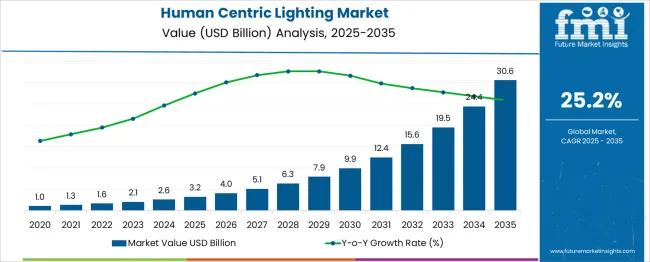
| Metric | Value |
|---|---|
| Human-Centric Lighting Market Estimated Value in (2025 E) | USD 3.2 billion |
| Human-Centric Lighting Market Forecast Value in (2035 F) | USD 30.6 billion |
| Forecast CAGR (2025 to 2035) | 25.2% |
The market is gaining momentum as organizations and institutions prioritize occupant well-being, circadian rhythm alignment, and energy efficiency. This transformation is supported by growing scientific evidence linking light exposure with physiological and psychological health, particularly in workplaces, healthcare environments, and educational settings. The market is witnessing a shift from static lighting to dynamic, tunable solutions that adjust color temperature and intensity in accordance with natural light patterns.
Advancements in LED technology, smart lighting controls, and sensor integration have further enabled the development of intelligent HCL systems. In response to sustainability goals and employee wellness programs, enterprises are increasingly deploying lighting solutions that align with human biological needs throughout the day.
Regulatory support for indoor environmental quality and increased awareness about the impact of artificial lighting on sleep cycles and productivity are expected to sustain long-term demand. The market outlook remains positive, with continued innovation in lighting automation and cloud-based lighting management platforms accelerating adoption across diverse use cases.
The human-centric lighting market is segmented by solution, installation type, application, and geographic regions. The solution of the human-centric lighting market is divided into Lighting Fixtures, Hardware, Lighting Controllers, and Software Service. In terms of installation type, the human-centric lighting market is classified into New Installation and Retrofit. Based on application of the human-centric lighting market is segmented into Commercial, Residential, Industrial, InstitutionalHealthcare.
Regionally, the human-centric lighting industry is classified into North America, Latin America, Western Europe, Eastern Europe, Balkan & Baltic Countries, Russia & Belarus, Central Asia, East Asia, South Asia & Pacific, and the Middle East & Africa.
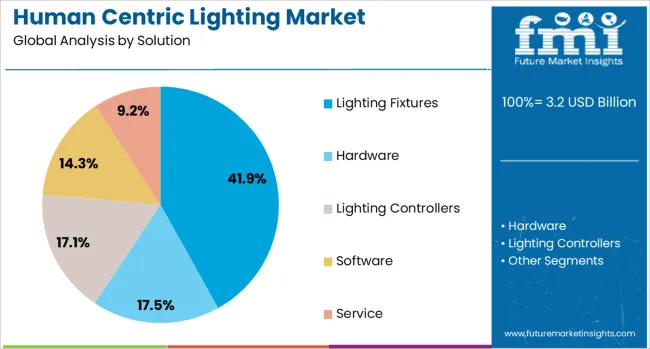
Lighting fixtures are projected to hold 41.9% of the revenue share in the Human Centric Lighting market in 2025, making it the leading solution segment. The segment's growth has been driven by increasing demand for hardware-integrated platforms that support dynamic lighting control and biological lighting principles. High compatibility with tunable white LEDs and sensor-based feedback loops has enabled fixtures to adapt light intensity and spectral composition in real time.
Commercial and institutional spaces have adopted these systems to enhance occupant comfort, support alertness, and reduce visual fatigue. The capability of fixtures to house advanced optics and thermal management systems has further improved their performance and reliability across long operational hours.
Integration with intelligent building systems and IoT platforms has elevated their functionality beyond basic illumination, making them critical components in wellness-centered building design. The widespread availability of customizable fixtures in different architectural styles and mounting configurations has also contributed to their high adoption rate in both retrofitting and new construction projects.
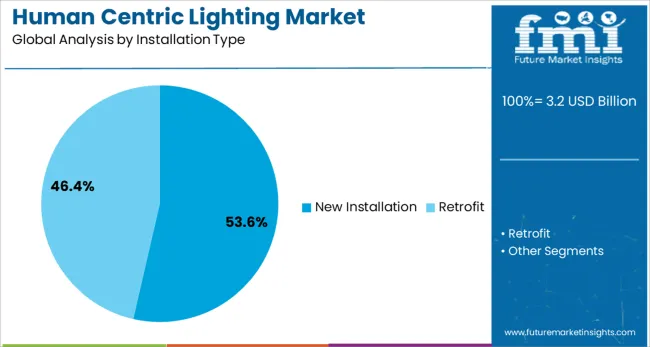
New installation is anticipated to account for 53.6% of the revenue share in the Human Centric Lighting market by 2025, positioning it as the dominant installation type. This growth is being supported by the proliferation of new commercial developments and institutional facilities that are incorporating human-centric lighting from the initial design phase. Developers and architects are integrating tunable and adaptive lighting systems to meet rising expectations for sustainable, occupant-centric environments.
As governments and certifying bodies promote green building certifications and wellness standards, new construction projects are prioritizing dynamic lighting solutions to enhance cognitive performance and comfort. The ease of integrating digital control networks, daylight harvesting sensors, and circadian-responsive algorithms in new structures has made this segment highly attractive.
Additionally, the availability of scalable HCL technologies and cost efficiencies achieved through pre-planned installations have encouraged broader adoption. The ongoing shift toward smart infrastructure and digitally enabled workspaces further reinforces the preference for embedding HCL solutions during the construction phase.
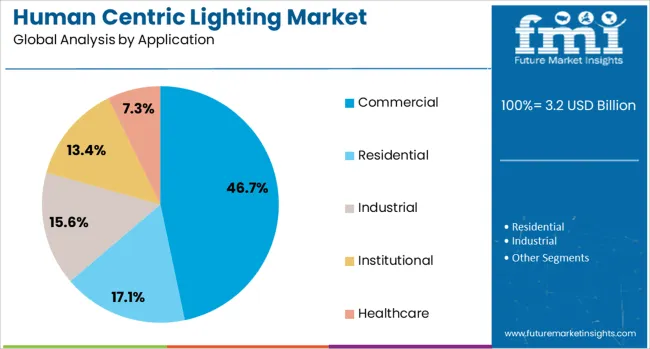
The commercial application segment is expected to contribute 46.7% of the Human Centric Lighting market revenue in 2025, maintaining its position as the primary deployment area. The rising emphasis on workplace wellness, employee retention, and productivity has led organizations to adopt biologically aligned lighting environments. Human-centric lighting systems are being implemented across offices, co-working spaces, retail outlets, and hospitality venues to influence mood, focus, and circadian alignment.
The ability to adjust lighting conditions based on time of day, user activity, and natural light availability has provided commercial operators with both energy savings and enhanced user experiences. Integration with building automation systems and lighting management software has allowed for real-time adaptation and data-driven control, strengthening the business case for deployment.
In high-traffic and client-facing spaces, the use of dynamic lighting has also become a branding and aesthetic differentiator. As hybrid work models and experiential design gain traction, commercial properties continue to invest in HCL to create healthier, more engaging environments.
The human centric lighting market is growing as awareness increases about the impact of lighting on human well-being and productivity. These lighting systems adjust color temperature and intensity to mimic natural daylight, enhancing mood, sleep quality, and focus. As industries such as healthcare, education, and office environments seek solutions to improve employee and patient well-being, HCL is becoming essential. Technological innovations in LED systems contribute to market expansion, despite challenges related to initial costs and limited awareness. (90 words)
The demand for human centric lighting is driven by the growing emphasis on health, well-being, and productivity, particularly in workplaces and healthcare settings. HCL systems, which align with the circadian rhythm, offer significant benefits such as improved mood, cognitive performance, and better sleep. These systems are being increasingly adopted in offices, hospitals, schools, and homes. The shift towards healthier work environments, combined with the rising demand for smart homes and IoT-enabled devices, is pushing the adoption of HCL solutions. With more businesses prioritizing employee well-being, HCL is gaining traction, especially in commercial sectors.
One of the key challenges in the human centric lighting market is the high upfront cost of installation. Advanced HCL systems, including specialized lighting fixtures and controls, come with significant expenses that can deter businesses and consumers. Small enterprises or households may face budget constraints, limiting adoption. Moreover, limited awareness about the long-term benefits of HCL, particularly in regions with lower familiarity with these systems, can slow market growth. Integration with existing infrastructure and the need for skilled personnel for setup and maintenance can also add to the complexity and cost of implementation.
Technological advancements and expanding applications are creating numerous opportunities in the human centric lighting market. Innovations in LED lighting technology, sensor-based controls, and energy-efficient designs are making HCL systems more affordable and effective. The growth of IoT and smart home solutions further enhances the flexibility and functionality of HCL systems, enabling real-time adjustments. The increasing demand for wellness-oriented products, especially in offices, healthcare, and retail spaces, presents significant opportunities for market growth. The rising adoption of HCL in emerging markets, coupled with growing investments in smart buildings, offers additional avenues for expansion.
The human-centric lighting market is witnessing a trend toward integrating smart technology. Consumers and businesses are increasingly adopting smart systems that allow for customized lighting preferences, adjusting based on the time of day, activities, or individual needs. These systems provide users with greater control over light intensity and color temperature, improving comfort and productivity. The rise of AI and machine learning in lighting systems enables automated adjustments to optimize conditions. The focus on creating personalized environments to enhance sleep or focus is driving the development of more adaptable and user-centric lighting solutions.
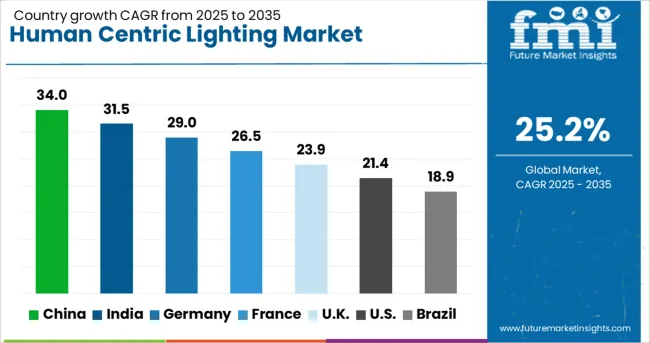
| Country | CAGR |
|---|---|
| China | 34.0% |
| India | 31.5% |
| Germany | 29.0% |
| France | 26.5% |
| UK | 23.9% |
| USA | 21.4% |
| Brazil | 18.9% |
The global human centric lighting market is expected to grow at an impressive CAGR of 25.2% from 2025 to 2035. China leads with a growth rate of 34.0%, followed by India at 31.5%. France is projected to grow at 26.5%, while the UK and USA are experiencing more moderate growth rates of 23.9% and 21.4%, respectively. The demand for human centric lighting solutions is being driven by increased awareness of their health and productivity benefits in sectors like office spaces, healthcare, and education. The rise in demand for energy-efficient lighting and advancements in LED technologies further support the market's growth across these regions. The analysis includes over 40 countries, with the top five detailed below.
The human centric lighting market in China is experiencing rapid growth, with a projected CAGR of 34.0%. The country’s industrial expansion, rising urbanization, and the growing focus on improving public health and well-being are the primary drivers of this growth. China’s government initiatives aimed at promoting smart cities and advanced technologies, including lighting solutions, contribute to the increasing adoption of human centric lighting systems. As industries, particularly in healthcare and education, adopt these solutions to improve worker productivity and student well-being, the demand for human centric lighting is expected to continue its upward trajectory.
The human centric lighting market in India is projected to grow at a CAGR of 31.5%. The country’s rapid industrialization, urbanization, and growing focus on energy-efficient technologies are driving the demand for lighting systems that improve health, productivity, and well-being. As India’s commercial, healthcare, and educational sectors increasingly adopt smart technologies, the demand for human centric lighting continues to rise. The Indian government’s support for the “Make in India” initiative, along with rising disposable incomes and awareness of health benefits, further fuels market growth. The expansion of the real estate sector is boosting the adoption of advanced lighting solutions.

The human centric lighting market in France is projected to grow at a CAGR of 26.5%. The demand for human centric lighting solutions is rising, particularly in sectors like healthcare, education, and commercial spaces. The growing awareness of lighting’s impact on human health, including sleep patterns, productivity, and mood, is driving adoption. France’s focus on energy-efficient solutions and smart technologies further accelerates the shift toward human centric lighting systems. The ongoing push toward healthier work environments, coupled with government-backed initiatives in energy efficiency, supports the growth of human centric lighting in the French market.
The UK’s human centric lighting market is expected to grow at a CAGR of 23.9%. The demand for these lighting solutions is driven by the focus on improving workplace productivity, well-being, and health outcomes. In the UK, industries such as healthcare, education, and commercial real estate are adopting human centric lighting systems to enhance performance and create healthier environments. The government’s focus on energy efficiency and improving the quality of life through smart technology is also fueling the adoption of human centric lighting in public and private spaces. The continued emphasis on well-being and comfort in urban areas supports steady market growth.
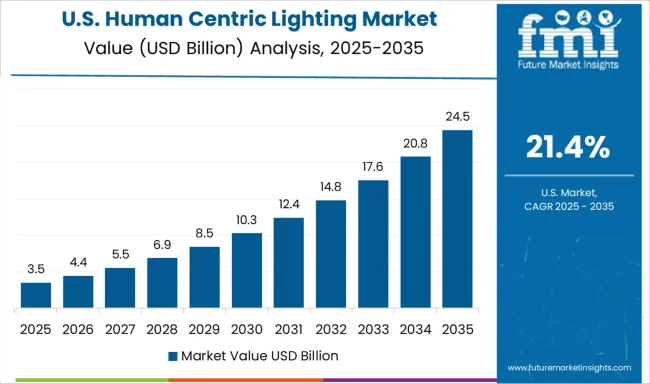
The USA human centric lighting market is projected to grow at a CAGR of 21.4%. The increasing demand for lighting solutions that optimize health, mood, and productivity is being driven by sectors like healthcare, education, and office spaces. The shift towards energy-efficient technologies, particularly LED lighting, is boosting the market for human centric lighting systems. The growing adoption of smart technologies and the expansion of the wellness industry contribute to the rising demand for lighting solutions designed to enhance human well-being. The USA market is poised to continue growing as industries seek innovative ways to improve the quality of their work and living environments.

The homopolymer acrylic filter bags market is driven by leading players providing high-performance filtration solutions for a wide range of industries, including chemical processing, cement manufacturing, and power generation. SLY Inc. is a major player, offering advanced homopolymer acrylic filter bags designed for industrial filtration applications, focusing on durability, high filtration efficiency, and resistance to chemicals. Donaldson Company Inc. is a key competitor, providing a wide variety of filtration products, including homopolymer acrylic filter bags, with an emphasis on enhancing productivity and operational efficiency in various industrial applications. W.L. Gore & Associates Inc. specializes in providing advanced filtration solutions, including high-quality acrylic filter bags, for industries requiring high-performance filtration systems that can withstand demanding operating conditions.
HL Filter USA LLC offers durable, high-efficiency homopolymer acrylic filter bags that cater to industries seeking reliable filtration solutions for air and liquid filtration processes. Zonel Filtech is known for offering custom filter bags, including homopolymer acrylic options, designed to meet specific industry requirements, with a focus on maximizing filtration effectiveness and improving process efficiency. Amrit Filter provides reliable filtration products, including homopolymer acrylic filter bags, designed to deliver high-quality filtration in industries like cement, chemicals, and textiles. Competitive differentiation in this market is driven by factors such as filter material quality, durability, filtration efficiency, and customization capabilities. Barriers to entry include the need for advanced manufacturing techniques, strict regulatory compliance, and the ability to offer cost-effective solutions. Strategic priorities include improving filter bag performance, enhancing material durability, and expanding product offerings for diverse industrial applications.
| Item | Value |
|---|---|
| Quantitative Units | USD 3.2 Billion |
| Solution | Lighting Fixtures, Hardware, Lighting Controllers, Software, and Service |
| Installation Type | New Installation and Retrofit |
| Application | Commercial, Residential, Industrial, Institutional, and Healthcare |
| Regions Covered | North America, Europe, Asia-Pacific, Latin America, Middle East & Africa |
| Country Covered | United States, Canada, Germany, France, United Kingdom, China, Japan, India, Brazil, South Africa |
| Key Companies Profiled | Signify, OsramLichtGroup, ZumtobelGroupAG, HubbellInc, Glamox, TRILUXGmbH&Co.KG, WiproLighting, Legrand, and Healthe |
| Additional Attributes | Dollar sales by filter bag type (air filters, liquid filters) and end-use segments (chemical processing, power generation, cement industry, textiles). Demand dynamics are influenced by the growing need for efficient filtration solutions, increasing regulatory standards for air and liquid quality, and the rising adoption of advanced filtration technologies. Regional trends show strong growth in North America and Europe, driven by industries such as power generation and chemical processing, while Asia-Pacific is expanding due to rapid industrialization and the growing demand for industrial filtration solutions. |
The global human-centric lighting market is estimated to be valued at USD 3.2 billion in 2025.
The market size for the human-centric lighting market is projected to reach USD 30.6 billion by 2035.
The human-centric lighting market is expected to grow at a 25.2% CAGR between 2025 and 2035.
The key product types in human-centric lighting market are lighting fixtures, hardware, lighting controllers, software and service.
In terms of installation type, new installation segment to command 53.6% share in the human-centric lighting market in 2025.






Full Research Suite comprises of:
Market outlook & trends analysis
Interviews & case studies
Strategic recommendations
Vendor profiles & capabilities analysis
5-year forecasts
8 regions and 60+ country-level data splits
Market segment data splits
12 months of continuous data updates
DELIVERED AS:
PDF EXCEL ONLINE
Lighting As A Service Market Size and Share Forecast Outlook 2025 to 2035
Lighting as a Service (LaaS) Market Size and Share Forecast Outlook 2025 to 2035
Lighting Product Market Size and Share Forecast Outlook 2025 to 2035
Lighting Contactor Market Growth – Trends & Forecast 2024-2034
Lighting Fixture Market
EV Lighting Market Growth - Trends & Forecast 2025 to 2035
LED Lighting Controllers Market
Strobe Lighting Market Size and Share Forecast Outlook 2025 to 2035
Runway Lighting Market Trends, Outlook & Forecast 2025 to 2035
Marine Lighting Market
Runway Lighting System Market
Plasma Lighting Market
Stadium Lighting Market Size and Share Forecast Outlook 2025 to 2035
Outdoor Lighting Market Growth – Trends & Forecast 2025 to 2035
Airport Lighting Market
Aircraft Lighting Market Size and Share Forecast Outlook 2025 to 2035
High End Lighting Market Size and Share Forecast Outlook 2025 to 2035
Hospital Lighting Market Size and Share Forecast Outlook 2025 to 2035
Military Lighting Market Size and Share Forecast Outlook 2025 to 2035
Wireless Lighting Market Size and Share Forecast Outlook 2025 to 2035

Thank you!
You will receive an email from our Business Development Manager. Please be sure to check your SPAM/JUNK folder too.
Chat With
MaRIA